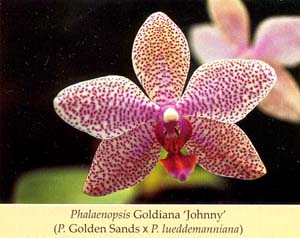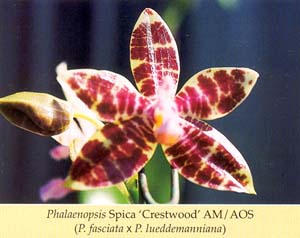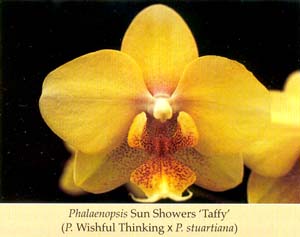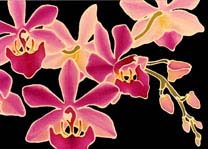Hybridizing with Phalaenopsis Species
by Bill Livingston
Phalaenopsis fasciata
|
Phalaenopsis fasciata helped open the door to some of our first modern day yellows. Its color ranges from light yellow, deep yellow to orange-yellow, with a greenish hue on some flowers. Flowers are waxy and firm to the touch. This heavy substance, as well as the cinnamon brown horizontal and transverse bars on all segments, can be passed on to its progeny. Why is this species not cultivated as often as a few years ago? Because other species and primary hybrids are now available to produce yellows. This species is easy to breed and grow, but the flower is quite star-shaped; when bred to large standard white flowers, the progeny as a rule will have only fair to good shape. Color varies from chartreuse to shades of yellow to darker yellows with orange-colored lips. A good example is P. Golden Sands (P. Fenton Davis Avant x P. lueddemanniana). Because the RHS does not recognize P. fasciata as a distinct species, it is lumped together with other species like P. lueddemanniana. Hybridizers know that the clone P.fasciata 'Field's' was one parent of P. Golden Sands. One drawback to using this species in breeding is the feathering, or streaking of red, along the leading edge of the petals on many of its hybrids. While some have said it was color break from a virus, in many cases this is not true. Others claim it is a "fatal flaw", but I believe it is simply an inbred characteristic. Using this characteristic in breeding perpetuates it in future hybrids. This species was a stepping stone in creating the first hybrid yellows, but many better clones are in use today. Several hybridizers recommend using yellow hybrids with this streaking or feathering characteristic when breeding with reds, as the streaking or feathering will blend with the red pigment. I haven't done this, as I do not really support this theory. Some red flowers being used today are showing color breaks; while I am not saying that a P. fasciata hybrid caused this condition, there is a strong possibility. I believe this characteristic is tied to a gene or a group of genes, but I do not believe they should be bred on. Be very selective when picking pod and pollen parents, so as to produce improved flower quality.
|



|



This article which has been reprinted here with permission, originally appeared in the Volume 66, Number 4 edition of Orchid Digest, (Oct-Dec 2002), which is a Special Edition that highlights Phalaenopsis, and also features an excellent article on Phal culture by the Tuskes. The Phalaenopsis Special Edition of Orchid Digest can be ordered from Orchid Digest for $22. Highly recommended.
This article, all of its sections and accompanying photographs
are copyright 2002 by Orchid Digest Corporation.
Note: This site uses Javascript Navigation Controls;
if you have Javascript disabled on your Browser,
you will need to use the Site Map to navigate this site.
|




